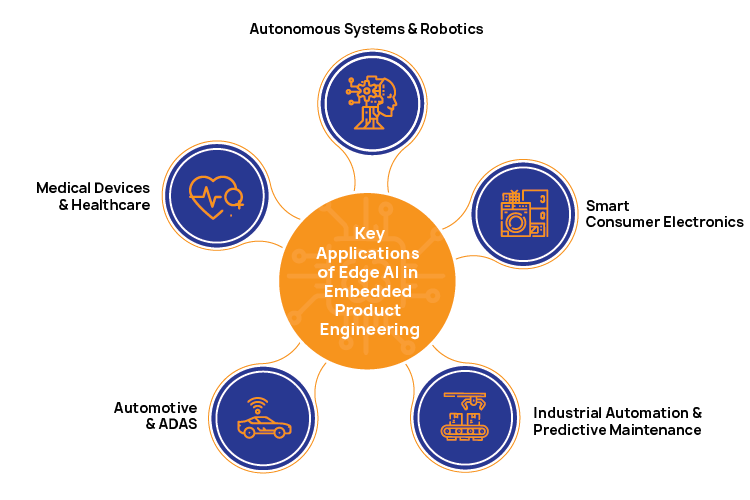

ACL Digital
5 Minutes read
The Rise of Edge AI in Embedded Product Engineering
Edge AI is transforming embedded product engineering by enabling intelligent, real-time decision-making directly on the device, eliminating the need for constant cloud connectivity. Unlike traditional AI models that depend on centralized processing, Edge AI runs locally, significantly reducing latency, improving data security, and enhancing power efficiency. This is particularly important in embedded systems, where performance must be balanced with strict limitations on power, processing, and connectivity. With the use of AI-optimized microcontrollers, neural processing units (NPUs), and lightweight AI frameworks, embedded devices can now handle advanced tasks like image recognition, anomaly detection, and predictive maintenance efficiently.
Industries that depend on embedded systems are quickly embracing Edge AI. In automotive, it powers Advanced Driver Assistance Systems (ADAS) for real-time hazard detection and autonomous control. In healthcare, it’s enabling diagnostic and monitoring devices that work without cloud dependency. Smart consumer devices from wearables to home assistants, use on-device AI for personalized, responsive interactions. In industrial automation, Edge AI supports robotics, predictive maintenance, and process optimization, helping reduce downtime and boost operational efficiency. As AI models become more hardware-efficient, Edge AI is reshaping the future of embedded systems, bridging the gap between performance demands and practical resource constraints.
Understanding Edge AI in Embedded Systems
Edge AI refers to deploying artificial intelligence models directly on embedded devices, enabling them to process data and make decisions locally without relying on the cloud. In the context of embedded product engineering, this means integrating intelligent capabilities into compact, power-efficient hardware that can perform real-time inferencing, even in environments with limited resources. Achieving this requires the use of AI-optimized processors, neural accelerators, and lightweight models designed to operate within tight memory and compute constraints.
Key differences between AI paradigms
- Traditional AI: Relies on offline model training and rule-based algorithms, lacking adaptability for real-time decision-making.
- Cloud-Based AI: Performs computation-intensive AI processing on remote servers, introducing latency, connectivity dependency, and security concerns.
- Edge AI: Processes AI workloads directly on the device, ensuring low latency, enhanced privacy, and operational resilience, even in network-constrained environments.
Benefits of on-device AI processing in embedded systems
- Real-Time Responsiveness: Enables instant decision-making for mission-critical applications like autonomous systems and medical diagnostics.
- Reduced Latency: Eliminates data transmission delays associated with cloud processing, crucial for time-sensitive operations.
- Enhanced Security & Privacy: Keeps sensitive data localized, mitigating risks related to cloud breaches and unauthorized access.
- Optimized Power & Bandwidth Usage: Minimizes reliance on continuous cloud connectivity, extending battery life and reducing data transfer costs.
- Scalability & Offline Functionality: Allows AI-powered embedded devices to function autonomously, even in remote or low-connectivity environments.
Core Technologies Powering Edge AI in Embedded Products
Edge AI in embedded systems relies on specialized hardware and streamlined software stacks to achieve low-latency intelligence in power- and memory-limited environments.
- AI-Optimized Microcontrollers and Processors: Modern microcontrollers (MCUs) and system-on-chips (SoCs) now come with built-in AI accelerators like TPUs and NPUs. These processors are designed to handle AI workloads locally, improving inference speed while keeping power usage low. Platforms such as NVIDIA Jetson, Google Edge TPU, and ARM Cortex-M with AI capabilities are widely used for edge deployments.
- TinyML and Lightweight AI Models: TinyML (Tiny Machine Learning) makes it possible to run AI models on devices with limited compute power. By using techniques like quantization, pruning, and knowledge distillation, models are made smaller and more efficient, enabling real-time AI processing on low-power embedded hardware without sacrificing too much accuracy.
- Optimized AI Frameworks for Embedded Systems: Frameworks like TensorFlow Lite, PyTorch Mobile, and ONNX Runtime are specifically designed for embedded environments. They support model compression and hardware acceleration, making it easier to deploy AI applications on memory-constrained devices with minimal overhead.
- RTOS Integration for Real-Time AI: Real-Time Operating Systems such as FreeRTOS, Zephyr, and QNX play a critical role in scheduling and managing system resources for AI tasks. Their deterministic nature ensures reliable, low-latency performance, essential for applications like robotics, autonomous vehicles, and industrial control systems.
Key Applications of Edge AI in Embedded Product Engineering
Edge AI is redefining embedded systems by bringing real-time intelligence directly to the source of data. Here are some of the most impactful applications:

- Autonomous Systems & Robotics: In robots, drones, and autonomous vehicles, Edge AI enables fast, local decision-making for tasks like object detection, navigation, and adaptive control. By processing sensory inputs on-device, embedded systems respond instantly to dynamic environments, ensuring precision and safety.
- Smart Consumer Electronics: From wearables to smart home devices, embedded AI delivers more personalized and responsive user experiences. Devices like smart assistants, fitness trackers, and security cameras use lightweight AI models to perform tasks such as voice recognition and activity prediction efficiently at the edge.
- Industrial Automation & Predictive Maintenance: Edge AI helps industrial systems detect anomalies and predict equipment failures in real time. By analyzing sensor data locally, embedded controllers can trigger timely maintenance actions, reduce downtime, and improve operational efficiency, without depending on cloud-based processing.
- Automotive & ADAS (Advanced Driver Assistance Systems): Vehicles now use Edge AI to process data from cameras, radar, and LiDAR sensors on the fly. This supports critical functions like lane detection, emergency braking, and adaptive cruise control, all while maintaining low latency and high reliability on embedded platforms.
- Medical Devices & Healthcare: Embedded AI is powering next-generation medical devices capable of real-time diagnostics and patient monitoring. Solutions like smart ECG monitors, portable ultrasound systems, and insulin pumps process data on-device to deliver immediate insights, even in low-connectivity or remote settings.
Challenges in Implementing Edge AI in Embedded Systems
While Edge AI offers significant advantages, integrating it into embedded systems brings a unique set of technical challenges that require thoughtful balancing of performance, efficiency, and security.
- Hardware Limitations: Embedded devices typically operate under tight power, memory, and compute constraints. Running AI models on such low-power platforms—like microcontrollers or AI-optimized processors, demands careful tuning to maintain performance without compromising energy efficiency. Although accelerators like NPUs and TPUs help, hardware resources remain limited.
- Model Optimization: AI models must be optimized to run effectively on embedded hardware. Techniques such as quantization, pruning, and knowledge distillation reduce model size and computational load while preserving accuracy, making real-time inferencing feasible even on constrained devices.
- Security and Privacy: Processing sensitive data on-device introduces risks like model tampering, adversarial manipulation, and data breaches. Ensuring robust security involves implementing secure enclaves, hardware encryption, and privacy-preserving methods like federated learning to protect both data and AI models.
- Scalability & Firmware Updates: Managing AI models across a large number of deployed devices adds complexity. Supporting over-the-air (OTA) updates and retraining pipelines is essential to ensure AI models stay current and reliable, all without disrupting real-time system performance.
Future Trends in Edge AI for Embedded Product Engineering
Edge AI is rapidly evolving, driven by breakthroughs in silicon design, smarter algorithms, and next-gen connectivity.
- AI at the Chip Level: The development of AI-specific chipsets such as NPUs (Neural Processing Units) and TPUs (Tensor Processing Units) is significantly enhancing the performance and efficiency of edge workloads. These low-power processors are optimized for deep learning inference and are embedded in platforms like ARM Ethos, NVIDIA Jetson, and Qualcomm AI processors, enabling intelligent processing at the device level with minimal latency and power consumption.
- Federated Learning and Distributed AI: Federated learning facilitates decentralized model training across multiple edge devices without transmitting raw data to the cloud. This approach strengthens data privacy, reduces bandwidth requirements, and is particularly beneficial in sectors such as healthcare, finance, and industrial automation where data sensitivity is paramount.
- Neuromorphic Computing: Inspired by biological neural systems, neuromorphic processors use spiking neural networks (SNNs) to achieve ultra-low-power AI inferencing. Chips like Intel Loihi and IBM TrueNorth offer energy-efficient, real-time AI processing capabilities, making them ideal for battery-operated embedded applications such as wearables, robotics, and autonomous drones.
- Integration of Edge AI with 5G & IoT: The convergence of Edge AI with 5G and IoT is enabling new possibilities for ultra-low-latency, intelligent applications. With the high-speed, reliable connectivity of 5G and the proliferation of AI-enabled IoT sensors, edge devices can process and act on data locally, improving responsiveness and reducing reliance on centralized cloud infrastructure in domains like smart cities, autonomous vehicles, and industrial robotics.
As companies navigate the adoption of Edge AI, a strategic approach is crucial to ensure scalability, efficiency, and security. ACL Digital brings deep expertise in embedded product engineering and Edge AI, delivering tailored solutions that optimize AI workloads for real-time performance. With a strong focus on hardware-software co-design, model optimization, and secure AI deployment, ACL Digital empowers businesses to build intelligent, future-proof embedded systems. By leveraging cutting-edge AI frameworks, domain-specific accelerators, and robust security architectures, ACL Digital helps OEMs accelerate their Edge AI journey, driving innovation across automotive, healthcare, industrial automation, and smart consumer devices.
To learn more about our Edge AI and Embedded Product Engineering services, get in touch with our experts.
Related Insights


The Architecture of Agentic RAG: Reasoning-Driven AI Systems Explained


The AI Developer’s Guide to Data Formats: TOON vs. JSON and Beyond


